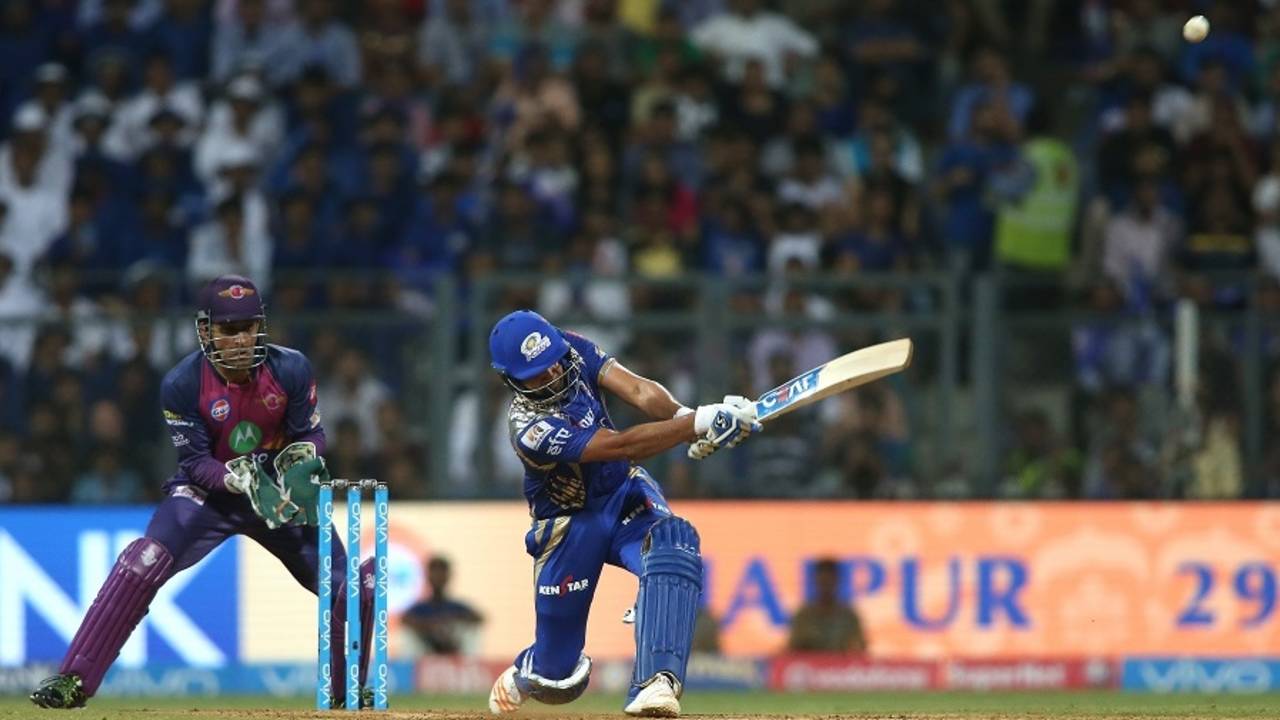Rohit Sharma's legspinning conundrum
Mumbai's captain has reached double digits just twice in eight innings this year while batting in the middle order, which could prompt a rethink about moving him back to open
Nikhil Kalro
24-Apr-2017
Rohit Sharma scored more runs against Rising Pune Supergiant on Monday than he had in Mumbai's first seven games combined • BCCI
When a batsman isn't picking the direction of spin, a cross-batted stroke, like a sweep or a reverse sweep, is the most logical option because it offers a wider second line of defence. Sweeping a legspinner means it is unlikely the ball will spin past the outside edge or will go through a bat-pad gap for a right-hander.
A flipper, a topspinner and a slider are flat-trajectory variations, so when a legspinner flights a ball, he limits his options to two - a legbreak or a googly. The raw probability of not picking that variation, therefore, is 50%. Top-order batsmen, struggling to pick a legspinner, are rarely willing to back themselves with that amount of chance, even in T20s.
So when Rohit Sharma chose a premeditated sweep off Amit Mishra in the ninth over against Delhi Daredevils last week, it wasn't the worst option. He may or may not have picked the googly from the hand, but he found deep square leg with a sweep he didn't keep along the ground. Perhaps Rohit's sweep was borne largely out of distrust in his ability to differentiate the googly from a legbreak, for his form against legspinners this IPL has been woeful.
Against Imran Tahir in Mumbai's first game against Rising Pune Supergiant, Rohit was done in by a slider, his feet rooted to the crease. He didn't pick the variation and was beaten in pace. Rohit played Tahir with more conviction and intent in Mumbai's loss to Rising Pune at the Wankhede Stadium on Monday night though, taking him for 23 runs off 15 balls, but still failed to pick the regulation legbreak from the googly.
Earlier in the season, Rohit was out lbw to a googly from Rashid Khan against Sunrisers Hyderabad, another delivery he failed to pick. He even failed to keep out Samuel Badree's hat-trick ball, another googly that sneaked between bat and pad. He struck an unbeaten 29-ball 40 against Gujarat Lions, who didn't have any wristspinners. Against Kolkata Knight Riders, he was out lbw - albeit to a poor umpiring decision - against Sunil Narine, another bowler he wasn't quite picking. The choice of stroke in all these dismissals was similar - offering a straight bat with a full face at the ball.
Against right-arm spinners this IPL before Monday's game against Rising Pune in Mumbai, Rohit had been dismissed five times and scored just five runs in 15 balls. "I was trying to play with the spin, which is what we're taught, but these [legspinners] were bowling googlies, so I had to play against it," Rohit had said about his approach to legspin after his unbeaten 40 against Lions. "I decided to not play in the 'V'. I know it sounds stupid to not to play in the 'V' but that's how it is now."
Although his problems against legspin weren't accentuated before this season, Rohit's numbers are well below his average. Excluding the first year of the IPL, his highest strike-rate against legspin was 133.33 in 2012.
| Year | Inns | Runs | Bf | Dis | SR | Ave |
| 2008 | 8 | 68 | 45 | 1 | 151.11 | 68.00 |
| 2009 | 9 | 53 | 45 | 3 | 117.78 | 17.67 |
| 2010 | 6 | 44 | 40 | 0 | 110.00 | |
| 2011 | 6 | 31 | 41 | 3 | 75.61 | 10.33 |
| 2012 | 5 | 44 | 33 | 0 | 133.33 | |
| 2013 | 9 | 52 | 52 | 2 | 100.00 | 26.00 |
| 2014 | 8 | 29 | 31 | 1 | 93.55 | 29.00 |
| 2015 | 11 | 78 | 65 | 2 | 120.00 | 39.00 |
| 2016 | 7 | 45 | 41 | 1 | 109.76 | 45.00 |
| 2017 | 6 | 28 | 30 | 5 | 93.33 | 5.60 |
What are his options then? The simple solution is opening the batting. Rohit does it for India in T20Is and has also opened for Mumbai in previous seasons. But that could displace the relatively successful pair of Jos Buttler and Parthiv Patel. Rohit had said batting himself at No. 4 improves the balance of the side and also opens up the possibility of him finishing games.
If he replaces Parthiv, that would mean either Buttler taking the gloves - which he does for England - or not making full use of Parthiv's potential in utilising the Powerplay. After the Powerplay in the IPL, Parthiv averages just 20.36 with a strike rate of 119.16. In T20 terms, that equates to an inefficient use of resources.
However, pushing Buttler down the order wouldn't affect Mumbai's top order much, nor would it disrupt their balance. He has played 52 of his 53 T20I innings in the middle order, with a strike rate of 139.20. Buttler has played the finishing role for England for his whole international career, save one innings. Rohit has batted in the top order for the majority of his. A simple swap makes all the sense in the T20 world, efficient utilisation of resources and all. Despite their success this season, are Mumbai willing to alter their winning style?
Nikhil Kalro is a sub-editor at ESPNcricinfo
